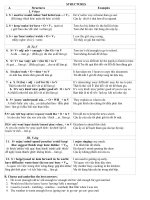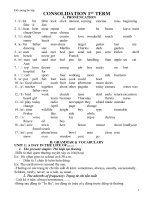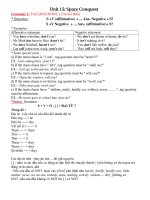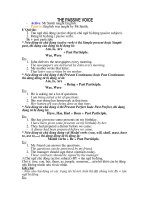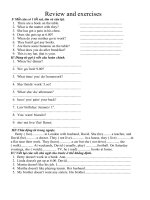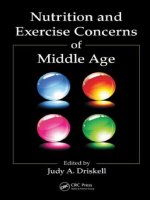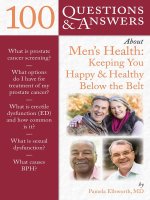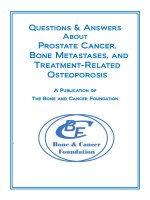100 questions & answers about sports nutrition and exercise
Bạn đang xem bản rút gọn của tài liệu. Xem và tải ngay bản đầy đủ của tài liệu tại đây (2.31 MB, 276 trang )
Praise for 100 Questions & Answers About Sports Nutrition and
Exercise
“100 Questions & Answers About Sports Nutrition and Exercise is a great
addition to any athlete’s or coach’s library. It provides straightfor-
ward explanations for key topics that will help optimize performance.
The book’s format with easy-to-read tables and Quick Fact sections
allow readers to immediately access the information they need. Per-
fect for those pressed for time who need accurate information in
one convenient location! Also ideal for nutrition and fitness profes-
sionals who need a quick reference guide for commonly asked
questions.”
Kelli J. Kidd, MS, RD, CSSD
United States Military Academy Sports
Dietitian and Iron-Man Triathlete
“Sports nutrition plays such a vital role in an athlete’s performance
and overall health, yet, this area is often overlooked by even the most
well-intentioned athletes. 100 Questions & Answers About Sports
Nutrition and Exercise is an excellent resource for the entire spec-
trum of athletes, as it highlights the importance and relevance of
nutrition by covering an array of topics that appeal to everyone from
novice to professional. The practical information presented is com-
pressive, detailed, and well organized, and allows for immediate
application to enhance performance and promote well-being.”
Nina M. Schroder,MSW,LCSW-C
Former NCAA Division I Athlete
“Pop culture continues to affect so many areas of our lives. Fitness
and diet are no exception. This book is a much needed reference to
anyone serious about the ‘truth’ in exercise programming and nutri-
tion for performance. The authors have done an outstanding job of
identifying practical areas that most people are concerned about.
78866_FMxx_FINAL.QXP 2/1/10 2:12 PM Page i
They have presented the responses to those areas in a concise and
effective manner. This text will be an outstanding reference for the
novice developing a program for themselves or the expert looking
for additional means to assist them in explaining the ‘truth’ about
nutrition and exercise planning.”
Al Bransdorfer, PhD
U.S. Navy Aerospace Physiologist
78866_FMxx_FINAL.QXP 2/1/10 2:13 PM Page ii
100 Questions & Answers
About Sports Nutrition
and Exercise
Lilah Al-Masri, MS, RD, CSSD, LD
Quest Sports Science Center
Annapolis, MD
Simon Bartlett, PhD, CSCS, ATC
Quest Sports Science Center
Annapolis, MD
78866_FMxx_FINAL.QXP 1/27/10 5:23 PM Page iii
Jones and Bartlett’s books and products are available through most bookstores and online booksellers.
To contact Jones and Bartlett Publishers directly, call 800-832-0034, fax 978-443-8000, or visit our
website, www.jbpub.com.
Substantial discounts on bulk quantities of Jones and Bartlett’s publications are available to
corporations, professional associations, and other qualified organizations. For details and specific
discount information, contact the special sales department at Jones and Bartlett via the above
contact information or send an email to
Copyright © 2011 by Jones and Bartlett Publishers, LLC
All rights reserved. No part of the material protected by this copyright may be reproduced or utilized
in any form, electronic or mechanical, including photocopying, recording, or by any information storage
and retrieval system, without written permission from the copyright owner.
The authors, editor, and publisher have made every effort to provide accurate information. However,
they are not responsible for errors, omissions, or for any outcomes related to the use of the contents of
this book and take no responsibility for the use of the products and procedures described. Treatments
and side effects described in this book may not be applicable to all people; likewise, some people may
require a dose or experience a side effect that is not described herein. Drugs and medical devices are
discussed that may have limited availability controlled by the Food and Drug Administration (FDA)
for use only in a research study or clinical trial. Research, clinical practice, and government regulations
often change the accepted standard in this field. When consideration is being given to use of any drug
in the clinical setting, the healthcare provider or reader is responsible for determining FDA status of
the drug, reading the package insert, and reviewing prescribing information for the most up-to-date
recommendations on dose, precautions, and contraindications, and determining the appropriate usage
for the product. This is especially important in the case of drugs that are new or seldom used.
World Headquarters
Jones and Bartlett Publishers
40 Tall Pine Drive
Sudbury, MA 01776
978-443-5000
www.jbpub.com
Jones and Bartlett Publishers
Canada
6339 Ormindale Way
Mississauga, Ontario L5V 1J2
Canada
Jones and Bartlett Publishers
International
Barb House, Barb Mews
London W6 7PA
United Kingdom
Production Credits
Acquisitions Editor: Shoshanna Goldberg
Senior Associate Editor: Amy Bloom
Senior Editorial Assistant: Kyle Hoover
Production Director: Amy Rose
Production Manager: Julie Bolduc
Associate Production Editor: Jessica deMartin
Associate Marketing Manager: Jody Sullivan
V.P., Manufacturing and Inventory Control:
Therese Connell
Composition: Glyph International
Printing and Binding: Malloy, Inc.
Cover Credits
Cover Design: Carolyn Downer
Cover Printing: Malloy, Inc.
Cover Images: Top left: © Noam
Armonn/ShutterStock, Inc.; Bottom left:
© Radin Myroslav/ShutterStock, Inc.; Top
right: © Shawn Pecor/ShutterStock, Inc.;
Bottom right: © Photos.com
Library of Congress Cataloging-in-Publication Data
Masri, Lilah Al.
100 questions & answers about sports nutrition and exercise/Lilah Al Masri, Simon Bartlett.
p. cm.
Includes index.
ISBN 978-0-7637-7886-6 (alk. paper)
1. Athletes—Nutrition—Miscellanea. 2. Physical fitness—Nutritional
aspects—Miscellanea. 3. Sports. I. Bartlett, Simon. II. Title. III.
Title: 100 questions and answers about sports nutrition and exercise. IV.
Title: One hundred question & answers about sports nutriiton and exercise.
TX361.A8M374 2011
613.2'024796—dc22
2009052696
6048
Printed in the United States of America
14 13 12 11 10 10 9 8 7 6 5 4 3 2 1
78866_FMxx_FINAL.QXP 2/1/10 3:53 PM Page iv
This book is dedicated to all of our family and friends
for their encouragement and support.
Dedication
78866_FMxx_FINAL.QXP 1/27/10 5:23 PM Page v
78866_FMxx_FINAL.QXP 1/27/10 5:23 PM Page vi
Contents
Foreword xi
Preface xiii
Introduction xv
Part One: General Sports Nutrition 1
Questions 1–15 discuss general sports nutrition, including the following:
• Why should an athlete develop a nutrition and exercise plan?
• What is hunger?
• What should my training plate look like?
Part Two: General Exercise Concepts 23
Questions 16–34 review general exercise concepts:
• What are the health benefits of regular exercise?
• What are the basic principles of exercise that are needed to optimize training
and performance?
• Why should athletes warm up before and cool down after exercise?
Part Three: Before-, During-, and After-Exercise Nutrition 75
Questions 35–48 discuss the timing of meals and snacks:
• What should I eat before exercise?
• Should I eat before an early-morning workout?
• What types of foods should the athlete consume during exercise?
Part Four: Vitamins and Minerals 93
Questions 49–53 discuss vitamins and minerals:
• What role do vitamins play in an athlete’s diet?
• What role do minerals play in an athlete’s diet?
• What role does calcium play in athletic performance?
78866_FMxx_FINAL.QXP 1/27/10 5:23 PM Page vii
Part Five: Fluids 109
Questions 54–65 review fluid intake:
• Why should athletes consume water as part of their nutrition plan?
• Is thirst a good predictor of an athlete’s fluid needs?
• How much sweat can an athlete lose per hour of exercise in a hot environment?
Part Six: Weight Management 131
Questions 66–77 discuss weight and its management:
• How do I recognize a fad diet?
• What constitutes body composition?
• What role do body mass index, waist circumference, and waist-to-hip
ratio play in my performance?
Part Seven: Extreme Environments 159
Questions 78–81 explain more about extreme environments:
• What are the effects of acute high-altitude exposure on performance?
• What is the live-high/train-low concept?
• What are the considerations for athletes training or competing
in cold-weather ambient and/or water environments?
Part Eight: Nutritional and Exercise Considerations
for Special Populations 171
Questions 82–91 describe nutritional and exercise considerations for special
populations:
• What is lactose intolerance?
• What is the overtraining syndrome?
• How do I know whether my decreasing performance over the season
is related to overtraining or poor nutritional habits?
Part Nine: Medications and Supplements 207
Questions 92–99 explain more about medications and supplements:
• Why has my exercising heart rate changed since I was put on beta-blocker drugs?
Other than age-adjusted heart rate, what methods can I use to gauge my exercise
intensity?
• What are ergogenic aids?
• What are ergolytics?
viii
100 QUESTIONS & ANSWERS ABOUT SPORTS NUTRITION AND EXERCISE
78866_FMxx_FINAL.QXP 1/27/10 5:23 PM Page viii
Part Ten: More Information 227
Question 100 provides resources for additional information about sports
nutrition and exercise:
• Where can I find more information about sports nutrition and exercise?
Bibliography 233
Glossary 235
Index 247
ix
100 QUESTIONS & ANSWERS ABOUT SPORTS NUTRITION AND EXERCISE
Contents
78866_FMxx_FINAL.QXP 1/27/10 5:23 PM Page ix
78866_FMxx_FINAL.QXP 1/27/10 5:23 PM Page x
Athletes, coaches, fitness trainers, and the general public are con-
tinually striving to achieve a higher level of fitness. As we plan
our training and give thought to our nutritional habits, we have a
variety of questions. We look for information that is concise and
comprehendible to assist us in achieving our goals.
Lilah Al-Masri and Simon Bartlett, who have devoted their
lives to the pursuit of excellence in fitness, created 100 Questions &
Answers About Sports Nutrition and Exercise for this purpose. This
book provides an excellent source of knowledge, covering an array
of exercise and nutritional information for everyone to use in his or
her quest to become healthier and more physically fit.
Stephen M. Cooksey
Head Track & Field Coach
U.S. Naval Academy
Foreword
78866_FMxx_FINAL.QXP 1/27/10 5:23 PM Page xi
78866_FMxx_FINAL.QXP 1/27/10 5:23 PM Page xii
Part One
Sports nutrition and exercise are very popular topics today. Too fre-
quently, athletes are exposed to nutrition and exercise information
that is not necessarily accurate or legitimate. Athletes are competi-
tive by nature, and with that competitiveness, they can fall prey to
bad advice. Our goal in this book is to present scientifically based,
usable, and concrete concepts that provide recreational and elite
athletes of all ages with information that will allow them to excel in
their respective sports. In addition, this book is designed to debunk
the many myths, superstitions, and misinformation that saturate the
fields of sports nutrition and exercise. The information in this book
is a supplement and is not a replacement for an individual nutrition
and exercise program that is designed by a sports dietitian and an
exercise physiologist, respectively.
The questions and answers in this book were inspired by the
most frequent concerns that we have encountered from athletes
throughout the years. All of the case studies in this book are based
on actual situations and events; therefore, the reader can be confi-
dent that the recommendations provide real-world solutions that
work when implemented correctly. Our intentions are to take out
the guesswork and replace it with simple and easy-to-use strategies.
We acknowledge all of the athletes who we have had the privi-
lege of encountering over the years. If it were not for their curiosity,
we would never have been inspired to write this invaluable book.
Preface
78866_FMxx_FINAL.QXP 1/27/10 5:23 PM Page xiii
78866_FMxx_FINAL.QXP 1/27/10 5:23 PM Page xiv
Lilah Al-Masri and Simon Bartlett have teamed up to combine
their expertise in sports nutrition and exercise physiology with
Olympic, collegiate, and professional athletes to create this book.
Both have considerable experience with developing nutrition and
exercise programs for athletes in a variety of sports. Working with
trainers, coaches, dietitians, physicians, and parents has helped to
expand their expertise to develop this book and fill a niche that was
missing. As nutrition and exercise researchers and consultants,
Al-Masri and Bartlett have coached clients to achieve successful out-
comes in a variety of athletic endeavors. This book completes your
understanding of nutrition and exercise interactions by concisely
answering your questions while providing individualized help with
understandable examples and illustrations based on real-world
experience. I am certain you’ll enjoy this book and use it as a refer-
ence because of the sound advice and recommendations for athletes
desiring to meet their goals with nutrition and exercise.
Laura Nihan, PhD, MS Ed, RD
Retired LTC USAF, Registered Dietitian
Introduction
78866_FMxx_FINAL.QXP 1/27/10 5:23 PM Page xv
78866_FMxx_FINAL.QXP 1/27/10 5:23 PM Page xvi
General
Sports
Nutrition
Why should an athlete develop a nutrition
and exercise plan?
What is hunger?
What should my training plate look like?
More
PART ONE
78866_PT01_FINAL.QXP 2/1/10 6:36 PM Page 1
Athletes must have a basic foundation in both general
and sports nutrition to benefit fully from its imple-
mentation. Athletes who fail to learn and implement
the basics of nutrition will be at a distinct disadvantage
when it comes to training, competing, and recovering.
Part One familiarizes the athlete with common ques-
tions and answers that will benefit all athletes who are
serious about improving their performance.
1. Why should an athlete develop a
nutritional and exercise plan?
Athletes need to feed their bodies continually in order
to perform at their peak. Practice, game, and tourna-
ment play place specific nutritional and physical demands
on the athlete. These demands can be met with a well-
designed nutrition and exercise program. Achieving peak
performance requires that athletes understand and
implement the fundamental principles of sports nutri-
tion and exercise science for their sport. Key strategies
for a successful performance will include preparation
before, during, and after exercise. For athletes to achieve
optimal performance, they must take into account the
physical demands of their sport (intensity, duration,
frequency), their size, and the environment (temperature,
humidity, etc.) in which they practice and compete. All
of these factors contribute to the sport-specific nutri-
tional and exercise plan that will assist the athletes in
achieving their athletic goals.
2. What is hunger?
Hunger is an unpleasant sensation that an individual
experiences when circulating blood glucose levels
decrease; it can be alleviated through eating. Hunger
should be avoided by all athletes to help prevent energy
loss. Athletes must be aware of the signs of hunger.
2
100 QUESTIONS & ANSWERS ABOUT SPORTS NUTRITION AND EXERCISE
Key strategies
for a successful
performance
will include
preparation
before, during,
and after
exercise.
Hunger
An unpleasant sensa-
tion that an individ-
ual experiences when
circulating blood glu-
cose decreases; it can
be alleviated through
eating.
Blood glucose
Amount of glucose
circulating in the
bloodstream.
Glucose
One of the most
commonly occurring
simple sugars in
nature. Humans rely
on glucose for cellu-
lar energy.
78866_PT01_FINAL.QXP 2/2/10 11:15 AM Page 2
Hunger appears in various ways, but most athletes rec-
ognize hunger by only stomach pangs. After stomach
pangs have been sensed, too many hours have passed
without feeding the body. Other hunger cues can
include fatigue, poor concentration, headaches, irri-
tability, shakiness, and sleep disturbances. These symp-
toms are usually felt before the stomach pangs and
should be acted on immediately to prevent more intense
hunger and additional energy loss. Being able to detect
your body’s hunger cues is important, as this will stabi-
lize energy and metabolism throughout the day, leading
to superior mental and physical performance.
■ Case Study
Nadia, a 20-year-old collegiate softball pitcher, presents
to the sports dietitian with complaints of headaches and
fatigue. She is confused about why she continues to get
headaches, as she drinks plenty of water throughout the
day and during practices. Nadia practices twice a day: 60
to 90 minutes of conditioning in the morning and 2 to 3
hours of skills practice in the afternoon. Nadia was
asked to keep a 1-week food and exercise log that also
emphasized rating her hunger level throughout the day.
On review, the sports dietitian noted that Nadia had a
hard time judging her hunger level, causing her to skip
meals and snacks. Nadia rarely feels hungry throughout
the day, but she often gets a headache a few hours after
her morning practice and when she is studying in the
evening. The sports dietitian reviewed some of the com-
mon signs of hunger with Nadia. Nadia was surprised
that hunger cues also include fatigue, poor concentra-
tion, headaches, irritability, shakiness, and sleep distur-
bances—not just stomach pangs. Nadia recognized that
she often experiences one or more of these symptoms
throughout the day. Nadia, together with the sports
3
100 QUESTIONS & ANSWERS ABOUT SPORTS NUTRITION AND EXERCISE
General Sports Nutrition
Stomach pangs
A sharp feeling of
pain in the stomach.
Fatigue
Physical or mental
exhaustion from
overexertion.
78866_PT01_FINAL.QXP 2/1/10 6:36 PM Page 3
dietitian, developed a consistent meal and snack plan
that would fit around her busy academic and athletic
schedule. After just one day of following the plan, Nadia
reported that her headaches subsided and her concen-
tration in the classroom and on the field had greatly
improved.
3. What should my training plate look like?
An athlete’s plate should be balanced between carbo-
hydrate, protein, and fat food sources. Choose complex
carbohydrates, lean proteins, unsaturated fats, and
plenty of fruits and vegetables to ensure variety in the
diet. The following total calorie intake is recom-
mended: carbohydrates, 50% to 60%; proteins, 15% to
20%; and fats, 20% to 30%. Carbohydrates include
fruits, vegetables, breads, rice, pasta, potatoes, cereal,
oatmeal, pretzels, and crackers. Lean proteins include
chicken and turkey without the skin, fish, lean cuts of
beef and pork, eggs, beans, nuts, nut butters, soy, and
low-fat dairy products (skim and 1%). Healthy fats
include oils, nuts, seeds, fatty fish, avocado, and nut
butters. Figure 1 represents what an athlete’s training
plate should look like in relationship to the distribu-
tion of carbohydrates, proteins, and fats. A specific
designation for fats is not included on the plate dia-
gram, as fats are sprinkled in throughout the day in
the foods that are consumed and in the way foods are
prepared (sautéing, stir frying, and using oil-based
dressings). Athletes can easily use the figure as a visual
guide for proper eating both at home and on the road.
4
100 QUESTIONS & ANSWERS ABOUT SPORTS NUTRITION AND EXERCISE
Carbohydrates
The main source of
energy for all body
functions, particu-
larly brain and muscle
functions; necessary
for the metabolism of
other nutrients.
Protein
Made up of amino
acids that act as the
building blocks for
muscles, blood, skin,
hair, nails, and the
internal organs.
Fat
A wide group of com-
pounds that may be
either solid or liquid
at room temperature.
Lean proteins
Protein sources that
are low in saturated
or trans fats, includ-
ing beans, nuts, nut
butters, eggs,
chicken, turkey, fish,
and soy.
Complex
carbohydrates
A carbohydrate com-
posed of two or more
linked simple-sugar
molecules.
Quick Fact
Add a variety of colors to your plate; eating an assort-
ment of fruits and vegetables will provide nutrients
and flavor to your meals.
78866_PT01_FINAL.QXP 2/1/10 6:36 PM Page 4
4. Why are carbohydrates important for
exercise?
Carbohydrates are the single most important source of
energy for athletic performance. They are a rapid
source of fuel to the working muscle and are burned
efficiently with or without the presence of oxygen.
Carbohydrates are oxidized (broken down) three times
faster than fat and are the predominant energy source
for fueling both aerobic and anaerobic activity.
Carbohydrates are stored in the body’s muscle cells as
glycogen and can provide the athlete with approxi-
mately 2,000 to 2,400 calories of energy. Eating suffi-
cient amounts of carbohydrate in the daily diet (more
than 50%) will help the body preserve its muscle pro-
tein and assist in the use of fat as a fuel. Consuming
low-carbohydrate diets is not recommended, as they
cause a decrease in muscle glycogen stores. This glyco-
gen decrease can lead to premature muscle fatigue dur-
ing exercise and may result in the body using its
muscle protein as a source of energy. Athletes who
5
100 QUESTIONS & ANSWERS ABOUT SPORTS NUTRITION AND EXERCISE
General Sports Nutrition
Figure 1 An Athlete’s Training Plate.
Oxidized
A chemical reaction
with oxygen.
Aerobic
In the presence of air
or oxygen.
Anaerobic
In the absence of air
or oxygen.
Glycogen
The major carbohy-
drate stored in animal
cells, mainly in the
muscle cells and some
in the liver. Glycogen
is converted to glu-
cose and released
into circulation, as
needed, by the body.
78866_PT01_FINAL.QXP 2/1/10 6:36 PM Page 5
need to lose weight will discover that carbohydrates
aid in the fat-burning process, as fat burns in a carbo-
hydrate flame.
Carbohydrates are the key to muscle contraction,
nerve conduction, and brain function. Carbohydrates
should make up 50% or more of an athlete’s daily food
intake; anything less than 50% can compromise muscle
strength, muscle endurance, power, mental focus, and
recovery. Carbohydrates are essential before, during,
and after exercise in order for the athlete to attain
optimal performance and recovery.
The average athlete has the capacity to store approxi-
mately 400 to 500 grams of carbohydrate as glycogen
in the body. Glycogen is stored in the body at three
sites: muscle cells, liver, and blood (Figure 2). Muscle
cells are the largest source, storing approximately 300
to 400 grams (1,200 to 1,400 kcal). The liver is the
second largest storage site, containing approximately
75 to 100 grams (300 to 400 kcal). Blood is the small-
est site, circulating approximately 25 grams (100 kcal).
Training and carbohydrate loading positively influ-
ence the amount of muscle glycogen stored.
The glycogen that is used during exercise is specific to
the muscle being used. Although there are 300 to 400
grams of total glycogen stored throughout the muscles,
only a certain percentage can be used, depending on
which muscles are activated. A runner, for example, will
use the glycogen stores in the muscles of the lower
extremities (hamstrings, calves, and quadriceps), whereas
6
100 QUESTIONS & ANSWERS ABOUT SPORTS NUTRITION AND EXERCISE
Carbohydrates
should make
up 50% or
more of an
athlete’s daily
food intake;
anything less
than 50% can
compromise
muscle
strength,
muscle
endurance,
power, mental
focus, and
recovery.
Carbohydrate
loading
A method of increas-
ing a cell’s glycogen
content beyond its
usual capacity.
Nerve conduction
The transmission of
impulses throughout
the nerves in the
body.
Quick Fact
Very high-carbohydrate diets can raise blood triglyc-
eride levels, leading to increased fat stores and weight
gain.
78866_PT01_FINAL.QXP 2/1/10 6:36 PM Page 6
the glycogen in the upper extremity muscles (biceps, tri-
ceps, shoulders, and back) will be used only marginally.
5. What are the differences between simple
and complex carbohydrates?
Carbohydrates are either simple or complex. Simple
carbohydrates raise blood sugar levels quickly. Exam-
ples include bananas, raisins, white breads, and energy
gels. After simple carbohydrates have been digested,
they enter the bloodstream as glucose to provide a rapid
source of energy to the brain and exercising muscles.
Conversely, complex carbohydrates raise blood sugar
levels more slowly. Examples include whole-grain cere-
als, oatmeal, whole-grain breads, beans, and apples with
7
100 QUESTIONS & ANSWERS ABOUT SPORTS NUTRITION AND EXERCISE
General Sports Nutrition
Figure 2 Glycogen Storage Sites in the Body.
Simple
carbohydrates
A form of carbohy-
drate that exists as a
monosaccharide or
disaccharide.
Complex
carbohydrates
a carbohydrate com-
posed of two or more
linked simple-sugar
molecules.
78866_PT01_FINAL.QXP 2/2/10 11:03 AM Page 7
skin. After complex carbohydrates have been digested,
they will enter the bloodstream at a slower rate than
simple carbohydrates because of their higher dietary
fiber content. Complex carbohydrates provide a long-
term source of energy to the exercising muscle and have
a higher nutritional value than simple carbohydrates,
providing certain vitamins and minerals. Each type of
carbohydrate plays a specific role in the athlete’s train-
ing, competition, and recovery nutrition plan.
6. What are the general carbohydrate
recommendations for endurance athletes?
Carbohydrate requirements for endurance athletes will
depend on the intensity and duration of the exercise
or sport, total daily energy expenditure, gender, and
environmental conditions. Recommended guidelines
for carbohydrate intake range between 5 and 12 grams
of carbohydrates per kilogram of body weight. Table 1
depicts daily carbohydrate needs for various endurance
exercise durations. Total body glycogen content can
last an endurance athlete approximately 90 to 120
minutes of continuous endurance exercise. Athletes
engaged in high-intensity, short-duration activities
such as sprinting and strength training have a unique
carbohydrate requirement. These types of activities can
8
100 QUESTIONS & ANSWERS ABOUT SPORTS NUTRITION AND EXERCISE
Table 1 Recommended Carbohydrate Requirements for Various
Endurance Activities
Duration of Exercise Carbohydrate Recommendations
1 hour of exercise per day 5 to 7 grams of carbohydrate per
kilogram
Endurance: 1 to 3 hours of
exercise per day
7 to 10 grams of carbohydrate per
kilogram
Ultra endurance: 3 to 5 hours of
exercise per day
10 to 12 grams of carbohydrate per
kilogram
Dietary fiber
A complex carbohy-
drate obtained from
plant sources. It is
not digestible by
humans. Although
dietary fiber provides
no energy for cellular
activity, it does help
maintain a healthy
digestive system,
lower blood choles-
terol levels, and reg-
ulate blood glucose
levels.
Total daily energy
expenditure
Total amount of
calories (energy)
expended by the
body over a 24-hour
period.
78866_PT01_FINAL.QXP 2/1/10 6:36 PM Page 8
